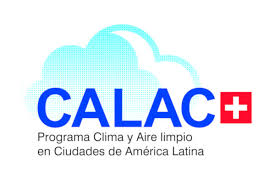CANADA (en)

/1/
Definitions of
non-road mobile
machinery
According to the Government of Canada’s Guidance Document on Off-Road Compression-ignition Engine Regulations (2012), for an internal combustion engine to be classified as an off-road machinery engine, it must meet the following criteria:
- It is (or will be) used in or on a piece of equipment that is self-propelled or serves a dual purpose by both propelling itself and performing another function (such as garden tractors, bulldozers, etc.).
- It is (or will be) used in or on a piece of equipment that is intended to be propelled while performing its function (such as lawnmowers).
- By itself or in or on a piece of equipment, it is handheld or portable, meaning designed to be and capable of being carried or moved from one location to another. Indicia of transportability include, but are not limited to, wheels, skids, carrying handles, dolly, trailer, or platform.
Most of the regulated engines are diesel-fuelled engines and are used in the construction, agricultural, forestry and mining sectors. This includes among others: tractors, excavators, log skidders, heavy haulers, bulldozers, handheld generators, as well as engines that supply electricity to a machine (e.g., refrigeration units).
Before the promulgation of CEPA, the Canadian government signed a commitment with the United States in 1991 to limit the transport of transboundary air pollutants reflected in the document called the Air Quality Agreement (Government of Canada and United States of America, 1991)
According to the Government of Canada’s Guidance Document on Off-Road Compression-ignition Engine Regulations (2012), the excluded engines are:
- Engines designed to propel an aircraft (e.g., an airplane)
- Engines designed to propel rolling stock (e.g., a locomotive).
- Compression-ignition marine engines rated at 27 kW and above and designed to propel a vessel.
- Engines that are used by on-road vehicles (e.g., a diesel-fuelled passenger car).
- Engines designed for competition and bearing a label to that effect.
- Engines designed exclusively for use in underground mining and open pit mining and which are certified by the Canadian Centre for Mineral and Energy Technology (CANMET) and the Mine Safety and Health Administration (MSHA).
- Engines that have a per cylinder displacement of less than 50 cm3.
- Engines designed exclusively in military machines designed for combat or combat support and bearing the combat use label.
- Engines being exported and accompanied by a written statement indicating that they will not be sold for use in Canada.
- Marine inboard engines.
- Stationary engines that bear a label.
- Engines used exclusively to provide electricity for small communities in remote areas and bearing a label to that effect.
- Engines mounted on electric generators used in back-up or emergency service.

/2/
Main regulatory
instruments for NRMM
emissions reduction
Regulations for off-road machinery in Canada are created under the authority of the Canadian Environmental Protection Act 1999 (CEPA) which, while not directly regulating NRMM, sets out the pathways and procedures in terms of stakeholders and responsible parties regarding the formulation and publication of laws and standards (CEPA, 1999; Government of Canada, 2012). Prior to the enactment of the CEPA, the Canadian government signed in 1991 a commitment with the United States to limit the transport of transboundary air pollutants in a document called the Air Quality Convention (AQC) (Government of Canada and United States of America, 1991) where measures were taken concerning the implementation of technologies aimed at reducing air emissions from industrial and mobile sources. This agreement served as the basis for the enactment of the CEPA and consequently for the generation of regulations aimed at the environmental control of off-road machinery in Canada.
Prior to the definition of specific standards for non-road machinery, Canada signed commitments called Memoranda of Understanding (MOUs) with 13 engine manufacturers in 2000. In these commitments, the manufacturers agreed to supply machinery with engines complying with the Tier 1 technology standard (Government of Canada, 2000).
Canadian environmental regulations for off-road machinery incorporate the following guidelines as defined by the United States Federal Code:
- 40 CFR § 89, control de emisiones de motores de encendido por compresión para uso fuera de carretera nuevos y en uso (estándares de emisiones Tier 1, 2 y 3).
- 40 CFR § 1039, control de emisiones de motores de encendido por compresión para uso fuera de carretera nuevos y en uso (estándares de emisiones provisionales Tier 4 y estándares de emisiones Tier 4).
- 40 CFR § 1068, disposiciones de cumplimiento general para programas de motores (regla que cubre disposiciones de cumplimiento general).
A compilation of different types of instruments identified in Canada for the control of air pollution generated by NRMM is presented in Table 1.
Tabla 1
Regulatory framework and identification of tools for emissions reduction of MMNC – Canada.
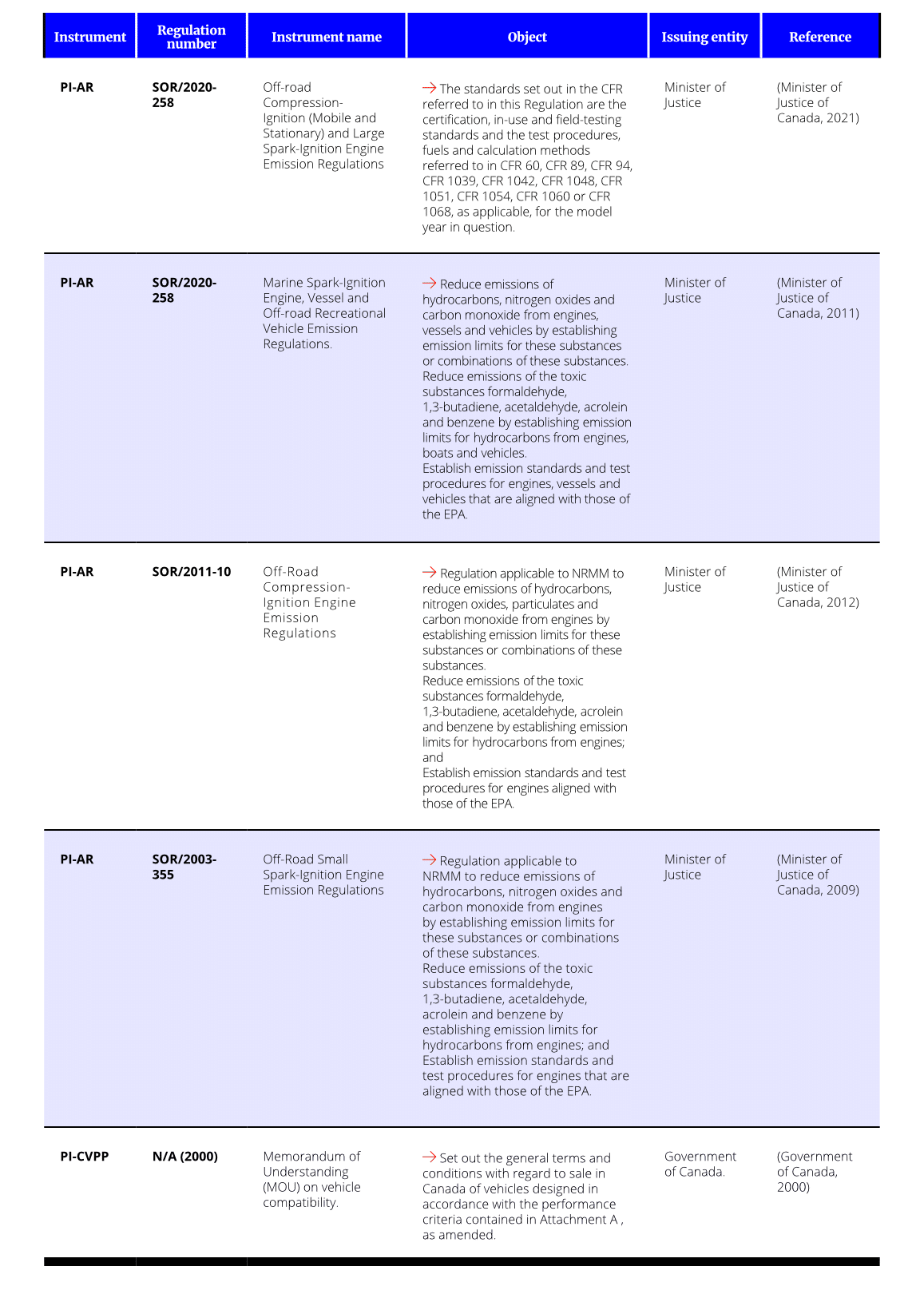

/3/
Emission standards
for air pollutants
Initially the air pollutant emission level regulation was defined in the Canadian Environmental Protection Act 1999 (CEPA, 1999) and subsequently reinforced through the Canada-United States Air Quality Agreement (Government of Canada and United States of America, 1991).
Prior to the definition of specific standards for NRMM or off-road machinery as the term is used in Canadian regulations, Canada signed Memoranda of Understanding (MOUs) The standards are defined in terms of mass of pollutant per unit of engine work, expressed in kilowatt hours. with 13 engine manufacturers in 2000 (Government of Canada, 2000). In these commitments, the manufacturers agreed to supply off-road machinery with engines complying with the Tier 1 technology standard.
According to the Transport Policy portal, there are different standards and adoption schedules for different types of engines. While compression-ignition off-road engines are aligned with US Tier 4 technologies, small spark-ignition engines operate to their own standard. Engines used in underground mining fall under provincial jurisdiction and marine engines comply with EPA regulations (Transport Policy, 2021).
Emission standards for off-road diesel engines were introduced in 2006. The measurement methods for Canadian off-road diesel engines are in line with the regulations defined by the EPA for the United States.
The regulated pollutants mentioned in section 10 of regulation SOR/2005-32 include carbon monoxide (CO), particulate matter (PM), non-methane hydrocarbons (NMHC) and nitrogen oxides (NOx). The emission standards are divided into classes according to engine power. The standards are defined in terms of mass of pollutant per unit of engine work, expressed in kilowatt hours.
The standards are aligned with those set by the EPA for the United States, and the regulations incorporate the following references:
- 40 CFR §89.112; 40 CFR §89.120; and
- 40 CFR §1039.101; 40 CFR §1039.102; 40 CFR §1039.105 and 40 CFR §1039.107
The regulation sets different emission standards and provisions for different types and power categories of engines. The following list presents a summary the various emission standards and provisions, as well as the corresponding sections of Regulation SOR/2005-32 (Minister of Justice of Canada, 2012) where these can be found:
- Emission control systems and defeat devices (section 9 of the Regulation);
- Exhaust emission standards (section 10 of the Regulation);
- Crankcase and smoke emission standards (section 10 of the Regulation);
- Adjustable parameters (section 11 of the Regulation);
- Transportation refrigeration unit alternate emission standards (section 11.1 of the Regulation);
- Replacement engines (section 12 of the Regulation); and
- Transition engine emission standards (section 13 of the Regulation)
The following tables summarise the emission standards adopted by Canada for the regulation of emissions from off-road engines for compression ignition engines.
Tabla 2
Emission standards for Tier 2 engines
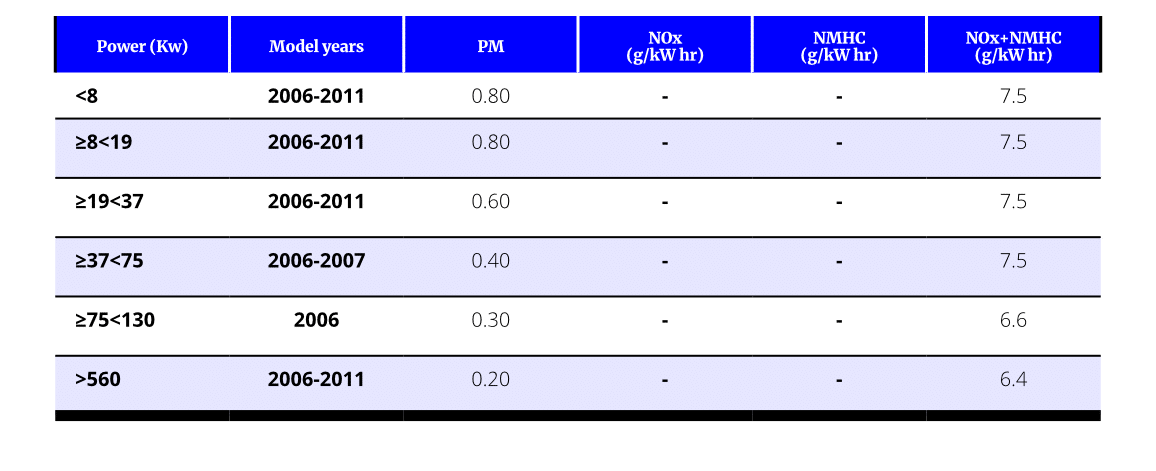
Fuente: (Government of Canada, 2012).
Tabla 3
Emission standards for Tier 3 engines

Source: (Government of Canada, 2012).
Tabla 4
Emission standards for provisional Tier 4 engines
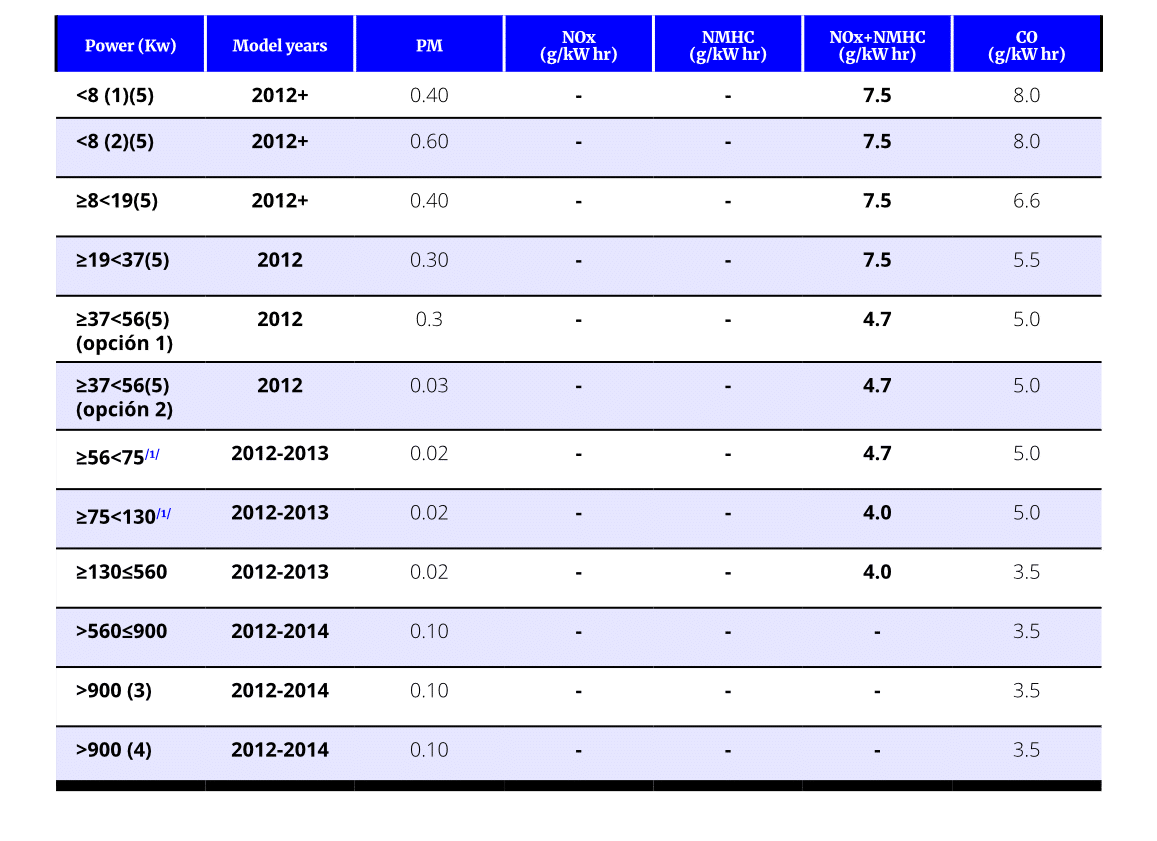
Source: (Government of Canada, 2012).
Tabla 5
Emission standards for Tier 4 engines
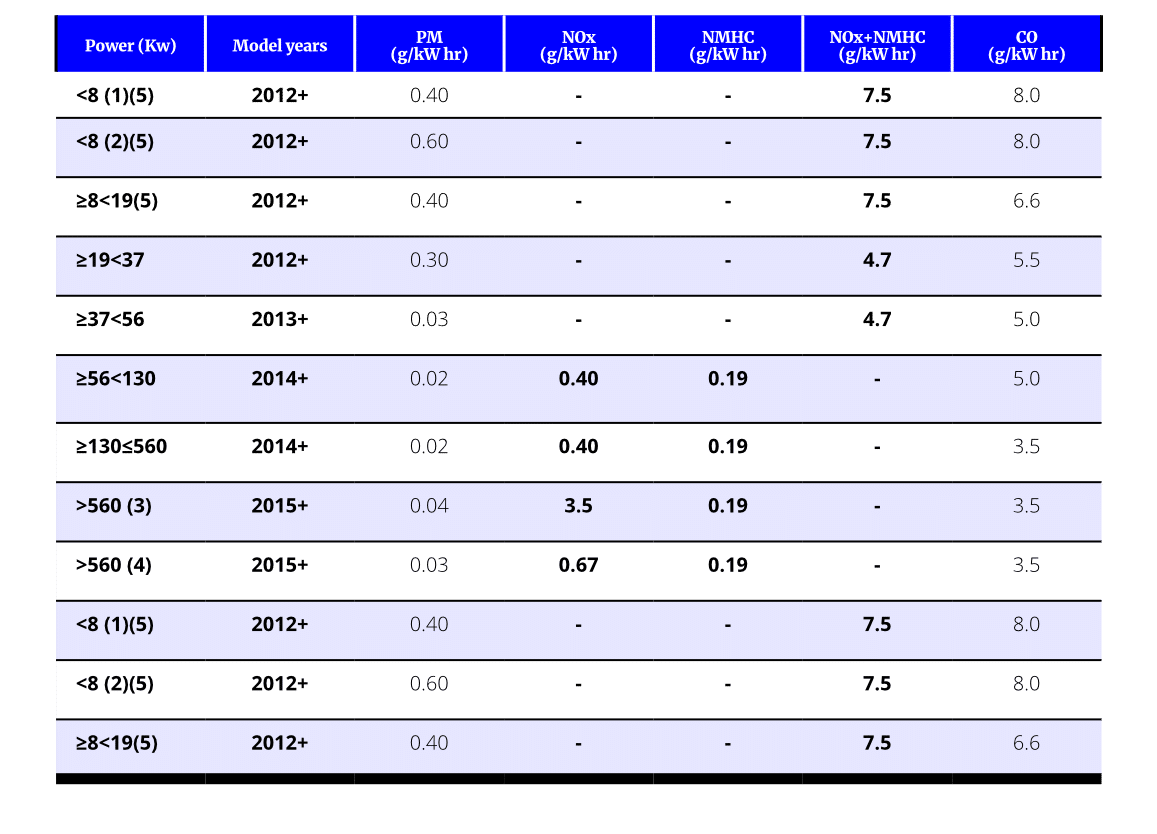
Fuente: (Government of Canada, 2012).
All engines except hand-start, air-cooled, direct injection engines.
(2) Hand-start, air-cooled direct injection engines.
(3) All except gen-set drive engines.
(4) Gen-set drive engines.
(5) Transient testing and NTE provisions for engines below 56 kW are delayed until 2013 in accordance with 40 CFR §1039.102 (a) (1) (i) and §1039.102 (g) (1).
1 For the 2011 model year, the Tier 3 standards apply.
(*) Some of the Tier 4 standards apply for the interim Tier 4 standards.

/4/
Import requirements
and type-approval
processes
4.1. Import requirements
The importation procedures for an engine are described in the Canadian Environmental Protection Act (CEPA, 1999) in paragraphs 153(1) (a), (b), (d) and (e), “Vehicles, engines and equipment standards”; “Compliance by companies”, 154 “Compliance on importation”, 155(1) (a), (b), (c) “Exceptions for certain importations”, 155(2) (a), (b) “Vehicle from United States and Mexico”; 155(3) (a), (b) “Change in standard since manufacture” and 155(4) “Imported vehicle or engine”.
Importers, whether individuals or companies, must generate an import declaration if 50 or more engines (in the case of companies) or 9 or more engines (in the case of individuals) enter Canadian territory. The declarations must be submitted to the Minister of National Revenue, which is the entity responsible for reviewing engine import declarations. (Minister of Justice of Canada, 2009, 2012, 2021).
These procedures apply to the following regulations:
- Emission regulations for off-road compression-ignition engines (mobile and stationary).
- Emission regulations for large off-road spark ignition engines (mobile and stationary).
- Emission regulations for small, spark ignition, off-road engines.
- Emission regulations for off-road compression-ignition engines.
In the case of importations of engines for use in vessels under the “Marine Spark-Ignition Engine, Vessel and Off-Road Recreational Vehicle Emission Regulations”, Importers, whether individuals or companies, must generate an import declaration if 50 or more engines (in the case of companies) or 9 or more engines (in the case of individuals) enter Canadian territory. importation declarations must be made only for companies importing at least 500 engines (subsection 37(3)) and exempts individuals importing fewer than 10 engines (subsection 37(2)) (Minister of Justice of Canada, 2011).
It is the importer’s responsibility to complete the importation declaration. The tables below show the information required for engines and machinery.
Tabla 6
Import format for engines

Fuente: (Minister of Justice of Canada, 2011).
Tabla 7
Import format for machinery

Fuente: (Minister of Justice of Canada, 2011).
Once the importation declaration forms are completed, they should be sent to the Regulatory Administration Section of the Transportation Division (Government of Canada, 2012).
The importation declaration covers engines installed in machinery and single engines in:
- Construction: bulldozers, backhoe loaders, tractors (loaders).
- Forestry sector: skidders, forwarders, and harvesters.
- Mining: drilling machines, crushers and grinders.
- Agricultural sector: tractors and sprayers.
For example, in the specific guidelines for the importation of engines to be used in off-road applications by both individuals and companies, the document “Off-Road Compression Ignition (Mobile and Stationary) and Large Spark-Ignition Road Engine Emission Regulations” sets out the steps and procedures for import declarations in the following sections: subsection 44 (1) “Declarations prior to importation”; 44(2) “Submission”, 44(3) “Importation of 50 engines or more”; 44(4) “Submission on time”; 44(5) “Replacement engines”. For individuals the procedures are set out in the following sections: subsection 45(1) “Declaration for person that is not a company”; 45(2) “Submission” and 45(3) “Exception”. (Minister of Justice of Canada, 2021)
4.2 Homologation processes
Type-approval tests are conducted in laboratories equipped with dynamometers and flue gas measuring devices. The type-approval methods used in Canada are in accordance with 40 CFR Subpart E – Exhaust Emission Test Procedures. A summary of the laboratory procedures used can be found in 40 CFR § 89.404 – Test procedure overview .

/5/
Labelling
processes
Canada adheres to the labelling requirements of the United States Code of Federal Regulations 40 CFR § 89.110 and 40 CFR § 1048.135 (see section 8.2). In addition, they have a national label, as explained in this section.
Off-road machinery that is manufactured and transported on Canadian territory must have the National Emission Mark (NEM) (see Figure 8.1). Some provinces do not require the use of the mark as long as the machinery is EPA certified (Government of Canada, 2012).
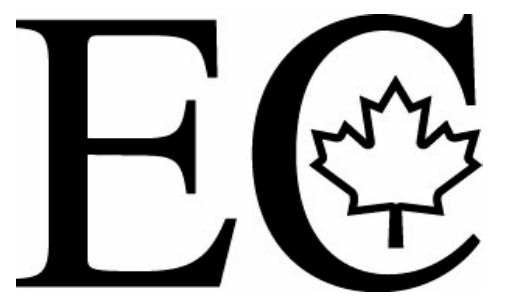
Etiqueta utilizada en motores usados en maquinaria fuera de vía en Canadá.
Fuente: (Government of Canada, 2012).
According to the Canadian government’s guidance document on emissions regulations for compression-ignition engines in off-road machinery (2012), the considerations for obtaining the NEM label are:
- Imported machinery may use the NEM mark as long as the new holder complies with the requirements to apply for the mark.
- For engines imported and assembled in Canada, if they meet EPA certifications, and if the emission control filter is installed in Canada in accordance with EPA guidelines, then the NEM mark is not required. However, if the emission control system is installed in a manner different from that indicated on the EPA certificate, then the company installing the emission control system must apply for an NEM mark.
- If a company receives an engine that is not EPA certified and is assembled in Canada, it must apply for NEM mark.
Characteristics of the mark
- The national emissions mark shall be at least 7 mm in height and 10 mm in width. The company authorization number assigned by the Minister to the company shall be in figures at least 2 mm in height and be located immediately below or to the right of the national emission mark.
- The national emissions mark shall be placed next to the EPA engine information label or, if there is no such label, in a visible, readily accessible location.
- The national emission mark must be on a permanently applied, weather resistant label that is readable.
Procedure for applying the national emissions mark
A company must submit an application to get the Minister’s authorization to use the national emissions mark. The following information must be included in the application:
- The name and street address of the head office of the company and, if different, its mailing address.
- A statement that the company is seeking to obtain the authorisation to apply the national emissions mark under these regulations.
- The street address of the location where the NEM will be applied.
- Information to show that the company is capable of verifying compliance with the standards in these regulations.
A company’s application must be signed by a person who is authorised to act on behalf of the company. When the Minister authorises a company to use the national emission mark, a company authorisation number will be assigned to the company. The company authorisation number is not to be confused with the unique identification number that must be engraved on every engine.

/6/
Regulation on machinery
useful life, repowering, overhaul and
scrapping practices
The useful life for NRMM is defined in subsection 1(1) of the Off-Road Compression Ignition Engine Emission Regulations as “the period of time or use in respect of which an emission standard applies to an engine, as set out in 40 CFR §1039.104-Subpart B.” (Government of Canada, 2012).
The following table summarises the useful lives for different engine categories applicable to the Canadian regulation.
Tabla 8
Life time for different engine categories.
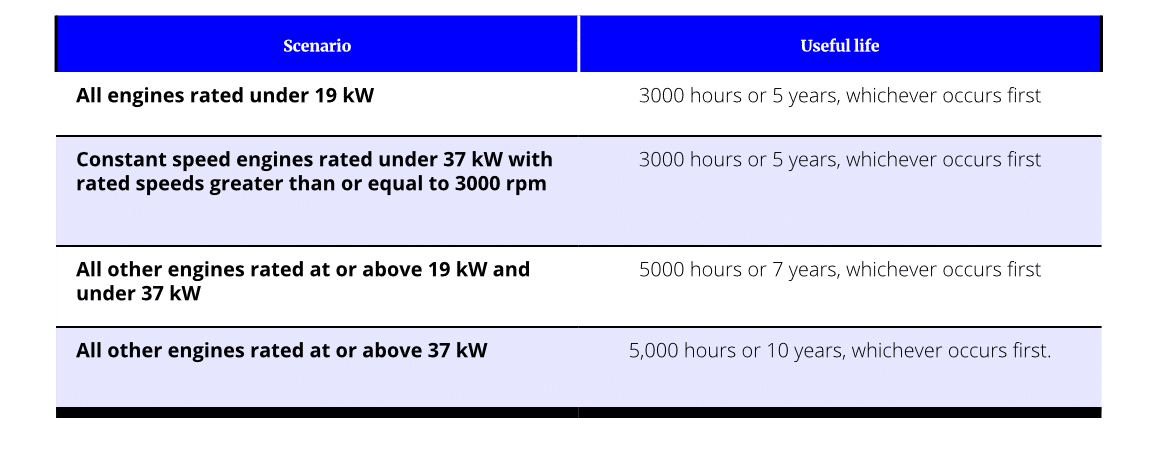
Fuente: (Government of Canada, 2012).

/7/
Operational and road
circulation requirements
7.1. Operation requirements
The operating requirements for engines or machinery used in off-road applications are described in the Canadian Environmental Protection Act and in the general regulation for off-road compression-ignition engines. In general terms, all equipment and vehicles must be EPA certified or carry an NEM label certifying that they meet the emission standards defined by the regulation.
Provinces may independently mandate certain off-road machinery operation requirements. For example, the provinces of New Brunswick/5/ and Ontario/6/ require that machinery meet certain mechanical criteria and that users of such machinery meet certain safety conditions (Government of Ontario, 2021; Government of New Brunswick, 2021).

/8/
Procedures for NRMM
control and inspection
in the operation stage
(No information for Canada)

/9/
Actors in import processes, manufacturing, registration, marketing, control and final practices of useful life of the MMNC
En la siguiente tabla se presentan los principales actores que se identificaron para los procesos asociados a la MMNC en Canadá.
Tabla 9
Stakeholder and roles – Canada
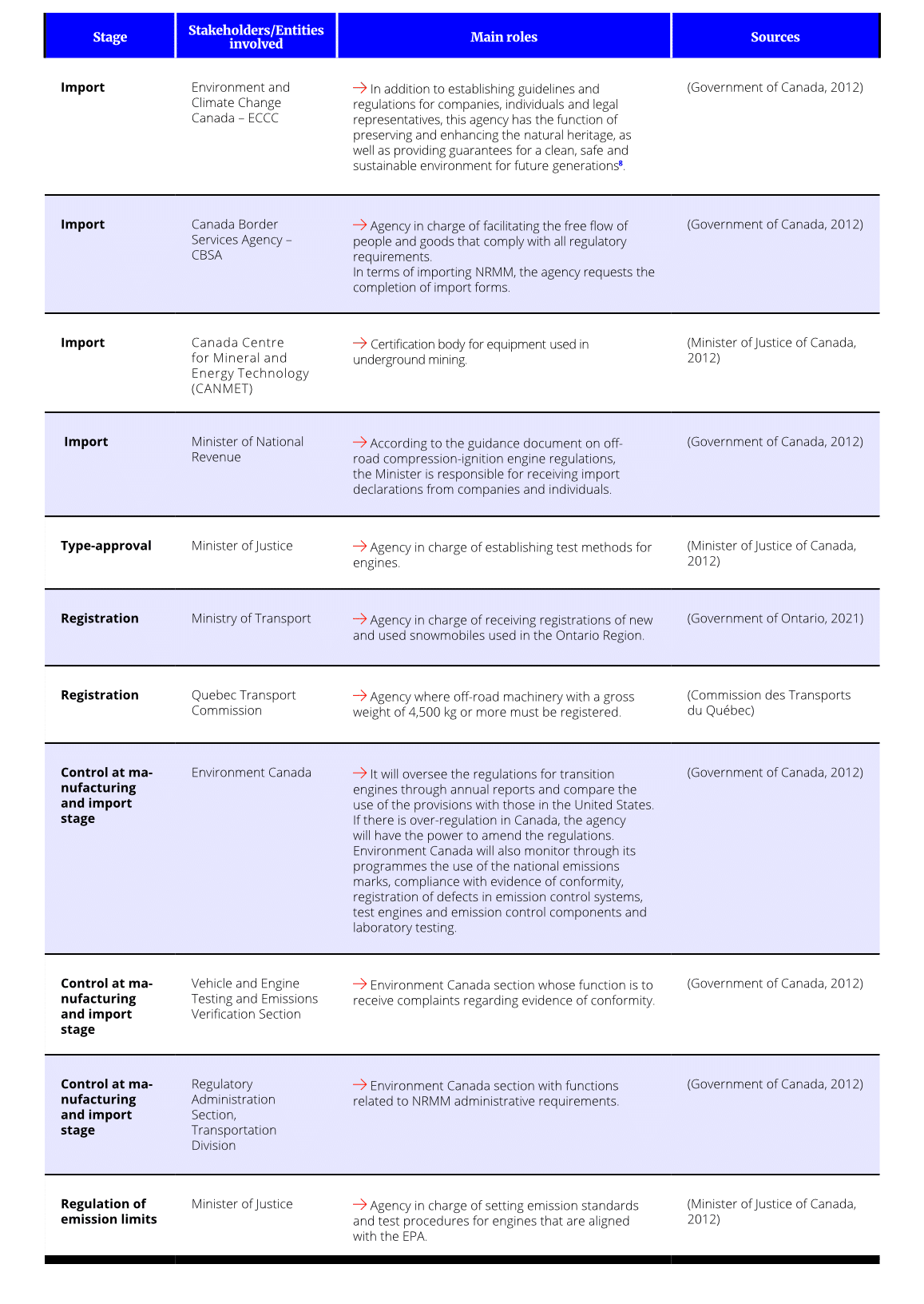
Fuente: elaboración propia.
The following part of this section provides additional information on NRMM-related processes and the stakeholders involved in each process.
Import
According to the Canadian Environmental Protection Act (1999), the main stakeholders in the process of importing off-road engines and machinery are, primarily, companies, individuals and legal representatives.
- Companies: in section 149 of the Act, a company is defined as a “person” who:
- Is engaged in the business of manufacturing vehicles, engines or equipment in Canada.
- Is engaged in the business of selling to other persons, for the purpose of resale by those persons, vehicles, engines or equipment obtained directly from a person or the agent of such a person.
- Imports of any vehicle, engine or equipment into Canada for the purpose of sale (includes importing equipment for lease).
- Persons: Natural persons importing at least 9 engines intended for off-road applications on land must submit a declaration to the Minister of National Revenue. Exceptions are made for persons importing more than 10 engines intended for vessels.
- Legal representative: Person with the power to sign import declarations, whether for a company or an individual
These stakeholders are regulated by national institutions such as the Environment and Climate Change Canada Institute, the Canada Border Services Agency and the Minister of National Revenue (Government of Canada, 2012; Minister of Justice of Canada, 2012). The roles of each institution are explained below.
- Environment and Climate Change Canada (ECCC): An institution charged with preserving and enhancing the natural heritage and providing assurance of a clean, safe and sustainable environment for present and future generations/7/ .
- Canada Border Services Agency (CBSA): Agency responsible for providing integrated border services that support national security and public safety priorities. It facilitates the free flow of people and goods, including animals and plants, that meet all legislative requirements/8/.
- Minister of National Revenue: Agency in charge of receiving import declarations from companies and individuals.
Manufacturing and distribution
Manufacturer: is a person or company in Canada who, before selling the engine to a customer, performs one of the following activities (Government of Canada, 2012):
- Internal modifications to the engine (e.g., by adding or modifying emission control systems).
- Builds an engine in parts.
- Modifies an engine (e.g., retrofitting a diesel engine to run on natural gas).
Manufacturers’ obligations in terms of emissions are as follows:
- All Canadian manufacturers must use the national emissions mark on their engines.
- It must first determine whether the engine will be used in a stationary application and if so, apply the appropriate label for such use.
If the engine manufacturer produces a transient engine/9/ that will be used independently or within machinery, it must submit an annual report to Environment and Climate Change Canada, following the guidelines defined in subsection 13.1 (1) of SOR/2005-32 (Minister of Justice of Canada, 2012).
Distributor: a person who is engaged in the business of selling to others, engines obtained directly from a Canadian engine manufacturer or its agent.
Registration
In Canada, there is an Off-Road Vehicle Act for each of the provinces such as Ontario, New Brunswick, Manitoba, Alberta, Nova Scotia/10/, among others (Government of Alberta, 2020; Government of Ontario, 2019; Legislative Assembly of Manitoba, 2021; Legislative Assembly of New Brunswick, 2003). This Act establishes guidelines for registration, insurance and identification through licensing, among other NRMM provisions.
A common feature found for each of the provincial laws is that the requirements in terms of off-road vehicle registration only cover vehicles such as snowmobiles, off-road motorbikes, road maintenance vehicles and ATVs, excluding agricultural and construction machinery.
Some characteristics of the standards/11/ are explained below at the provincial level, for Ontario, New Brunswick and Quebec.
Registration process in Ontario
New and used snowmobiles must be registered with the Ministry of Transportation through the Ontario Service Centre (Government of Ontario, 2021).
The following vehicles do not need to be registered as off-road vehicles: road construction machines, agricultural vehicles, golf carts and motorised wheelchairs. In addition, off-road vehicles participating in a competition sponsored by a motorbike association with more than 25 members do not need to be registered for the event/12/.
New Nouveau Brunswick:
All off-road vehicles must be registered annually and display a valid registration plate.
The registration serves as a unique identifier and is mandatory for all types of off-road vehicles according to the provincial Off-Road Vehicle Act of New Brunswick.
Quebec:
According to the Quebec Automobile Insurance Corporation (Société de l’assurance automobile du Québec), off-road vehicle registration processes consider:
- Vehicles that have been designed to operate on public roads, but will be used on private roads, must be registered under a “V” type licence at an SAAQ/13/ service point .
- Vehicles registered for off-road use include cars, motorcycles, mopeds and scooters, trucks/14/ , motor homes/15/, buses and minibuses, snowmobiles, tool vehicles/16/ , trailers/17/ , camping trailers, motor home trailers, snow ploughs/18/ and military vehicles.
On the other hand, owners of off-road machinery with a gross weight of 4,500 kg or more must register with the Quebec Transport Commission (Commission des Transports du Québec).
Sale
In order for a company or person to sell an engine in Canada, it must comply with certain obligations within the parameters defined by the Canadian Environmental Protection Act (CEPA) (Government of Canada, 2012), as well as regulations for engines used in off-road machinery (Minister of Justice of Canada, 2012).
Among the general requirements to fulfil the obligations are providing invoices or proof of payment for the engine sold to the customer who purchases the engine for resale purposes, such as receipts and invoices from the customer whose business activity is leasing or selling engines to third parties.
Any engine marketed in Canada must have a National Emissions Mark (NEM) or EPA certificate.
The requirements for selling off-road engines are described below:
- Engines covered by an EPA certificate and sold concurrently in Canada and in the United States
Section 16 of SOR/2005-32 (Minister of Justice of Canada, 2012) identifies the evidence of conformity for an engine that is covered by a valid EPA certificate sold concurrently in Canada and the United States.
- Engines sold in the United States
An engine in addition to having a National Emissions Mark (NEM) and complying with section 153(2) must:
- If the engine sold in the United States belongs to the same family, you must provide the retail customer or lessee with the following:
- Copy of dated invoice to the first retail U.S. purchaser/leaser.
- Copy of dated invoice to a U.S. party who sells or leases at the U.S. retail level.
- Copy of dated purchase order between a U.S. party and the first U.S. retail purchaser/leaser.
- A dated advertisement of engine or engine family targeted at U.S. consumers (this could be sales brochure, printed ad, magazine, price list, etc.) demonstrating that the product was actively marketed and available for delivery in the U.S.
- A dated U.S. manufacturer/importer/dealer list for the machine model demonstrating that the product was actively marketed and available for delivery in the U.S. (Minister of Justice of Canada, 2009).
If the above evidence of conformity pertains to a machine within which an engine is installed, then the evidence must include supporting documentation matching the engine to the machine (Minister of Justice of Canada, 2009):
Before the import of an engine, before applying the NEM mark or, in the case of 153 (2), before the engine leaves the possession or control of the company, a company must ensure that it has the complete evidence of conformity available (including EPA Certification) and at least one of the above-listed concurrent sale documents that is appropriately dated. The evidence of conformity must be available prior to any of the above action taking place.
If the above is not done, the company shall provide evidence of conformity compliance in accordance with section G.4.2 of the Off-Road Compression-Ignition Engine Emission Regulation.
- Type 1 – Specifically listed on an EPA certificate and sold in Canada but not in the United States
Evidence of conformity must be submitted to Environment and Climate Change Canada, according to paragraph 17 (1) (b) of regulation SOR/2005-32 because the engine is not sold concurrently in both countries.
- Type 3 – Neither specifically listed on an EPA certificate nor sold concurrently in Canada and the United States
Evidence of conformity must be submitted to Environment and Climate Change Canada in accordance with paragraph 17 (1) (b) of regulation SOR/2005-32, if there is no valid EPA certificate covering the engine.
- Sale of transition engines
A transition engine sold in Canada in accordance with the Government of Canada must comply with the following conditions (Government of Canada, 2012):
- A machine of the same model is sold to the first retail buyer or leaser in the United States. This must be substantiated by any of the following:
- Copy of dated invoice to the first U.S. retail purchaser or leaser.
- Copy of dated invoice to a U.S. party who sells or leases at the U.S. retail level.
- Copy of dated purchase order between a U.S. party and the first U.S. retailer purchaser/leaser in the same country.
- A dated advertisement of the machine model targeted at US consumers (this could include sales brochure, printed ad, magazine, price list, etc.) demonstrating that the product was actively marketed and available for delivery in the United States.
- A dated U.S. manufacturers/importers/dealer list for the machine model demonstrating that the product was actively marketed and available for delivery in the United States.
All engines marketed within the provinces must have a national emissions mark unless the engines already have an EPA certificate.
Before the import of a transition engine and before applying the NEM, the company or individual must ensure that it has the complete evidence of conformity that the engine was manufactured as per the guidelines set forth in 40 CFR §1039.625.
Control and inspection
Minister of National Revenue: responsible for the administration of tax law and revenue collection; it is the agency in charge of issuing authorisations and labelling numbers (Minister of Justice of Canada, 2009, 2012, 2021).
Canada Centre for Mineral and Energy Technology (CANMET): certification body for underground mining equipment (Minister of Justice of Canada, 2012).
Environment Canada will oversee the regulations for transition engines through annual reports and compare the use of the provisions with those in the United States. If there is over-regulation in Canada, the agency will have the power to amend the regulations. Environment Canada will also oversee the following through its programmes:
- Use of the national emissions mark
- Evidence of conformity
- Recording of defects in emission control systems
- Test engines and emission control components
- Laboratory emission tests
Vehicle and Engine Testing and Emissions Verification Section: Hace parte de Environment Canada y su función es la de recibir quejas referentes a las evidencias de conformidad.
Regulatory Administration Section, Transportation Division: Hace parte de Environment Canada con funciones de atención a requerimientos administrativos relacionados con MMNC.
Consultation documents (downloadable)
